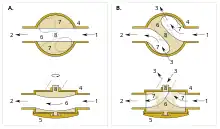Hagmann valve
The Hagmann Free-Flow Valve is a trademarked brass instrument valve design developed by Swiss musician and instrument technician René Hagmann, first introduced for trombone F attachments in 1990.[1][2] His intention was to address some of the geometrical limitations of the regular rotary valve, as well as the reliability and maintenance issues of the popular Thayer axial flow valve that arise from its relatively complex design.
Construction

Source: Figs. 1A–1E (prior art), Shires Tru-Bore patent.[3]
A standard rotary valve has a rotor with two valve ports, which deflect the air flow through a 90° turn when engaged. While this does not substantially affect the sound of instruments like the French horn or tuba, which already have many bends in the tubing, the characteristic sound of the trombone is partly due to its long straight air flow. The valve ports in rotary valves require a small radius 90° bend or "knuckle" shape which can impede the air flow, and some rotors add further impedance by using a smaller diameter than the instrument tubing, or an elliptical cross-section, to reduce the size and weight of the valve.
The Hagmann valve has a rotor with three ports. The default path uses one port, which passes straight through the center of the rotor with almost no deflection of the air flow. When engaged, the rotor turns only 60° and uses the other two ports to deflect the air path approximately 45° through the top of the rotor and into the valve tubing. This reduces the impedance of the air flow, providing an easier, more open "feel" for the player.[4] While the Hagmann valve does not achieve the low 20–25° angle of deflection in axial flow valves, it is still about as free-blowing and, being otherwise mechanically similar to a standard rotary valve, is also simpler to lubricate and clean.
The Hagmann valve is similar to several other three-port valve designs. US patents for the Bach balanced or "K" valve (granted 1995) and the Miller valve (granted 1998) show both employing a similar mechanism, but with S-shaped valve ports entirely contained within a rotor cylinder undergoing a 90° turn, and emerging from the sides of the taller valve casing, rather than the top.[5][6] Very few instruments were built and sold with these valves, and both patents have now expired.
The Shires "Tru-Bore" valve (US patent granted 2006) claims to improve Hagmann's design by mounting the valve on its side to simplify manufacturing, using a single-piece cast solid rotor instead of assembling it from brazed tubes, and eliminating the slight kink in the straight path to improve the air flow.[3]
Applications
Hagmann valves are available on trombones from several manufacturers, especially on their professional ranges, including Bach, Courtois, Haag, Rath, S.E. Shires, Schagerl, and Thein.
In 2004 Haag released a cimbasso in F built with five Hagmann valves. Although discontinued, this instrument is still used by several operas and orchestras, including Badische Staatskapelle, Hungarian State Opera, and Sydney Symphony Orchestra, as well as Swedish jazz musician Mattis Cederberg.[7]
References
- "International Trademarks: 667729 – RENE HAGMANN". Madrid Monitor. World Intellectual Property Organization. Retrieved 4 August 2022.
- "The René Hagmann Free-Flow Valve". Servette Music SA. Retrieved 18 July 2022.
- US patent 7112735, Shires, Stephen E., "Musical wind instrument, valves therefor, and methods of manufacturing same", issued 26 September 2006, assigned to S.E. Shires, Inc, class G10D9/04
- Hagmann, René (28 August 2018). "René Hagmann presents the Free Flow Valve for trombones". Servette-Music TV. Geneva, Switzerland. Retrieved 18 July 2022 – via YouTube.
- US patent (expired) 5396825, Kirts, Herbert L., "Air flow valve for musical instrument", issued 14 March 1995, assigned to Selmer Corporation, class G10D9/04
- US patent (expired) 5798471, Miller, Robert M., "Rotary valve for musical instruments", issued 25 August 1998, class G10D9/04
- "Haag Cimbasso Trombone C45HV". Musik Haag AG. Archived from the original on 12 March 2013.

_on_bass_trombone.jpg.webp)